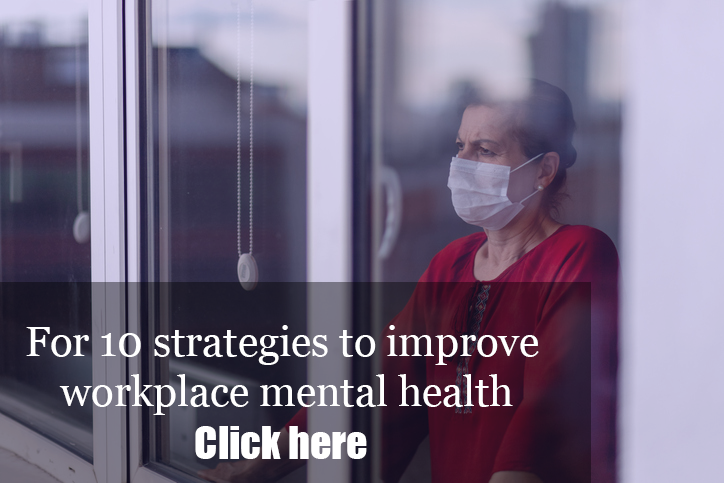Healthcare and benefits have been in the spotlight in a big way during COVID-19, with employers focusing on how to keep workers safe, healthy and happy during the pandemic.
But while employers undoubtedly have to continue to focus on supporting employees during the pandemic, smart organizations also need to think about how to ensure employees are helped in a post-pandemic world, says Kelly McDevitt, president of the Integrated Benefits Institute. One major way to do that? Urge employees to get the regular and preventive care they need now.
“They’re afraid to go to the doctor, go the hospital,” she says. But looking at disability claims for employees, “COVID is never going to make that top five, but all those others that are making the top five aren’t going anywhere. They’re still there.” Conditions like diabetes, musculoskeletal disorders and depression are all big and continuing issues that are hurting employees and employers. Meanwhile, significant rates of later diagnosed cancers with much poorer outcomes are expected as employees forgo screenings due to COVID-19.
In a recent conversation, McDevitt spoke about how COVID-19 is reshaping the benefits industry, the importance of preventive care—even during a pandemic—and why remote work will last.
HRE: You took the helm of IBI earlier this year, obviously at a significant time in history and a significant time in benefits. What’s that been like? What are your goals during this time?

Kelly McDevitt
McDevitt: Interesting—but I don’t know if that begins to cover it. More than ever, employers are looking for places to find information that is unbiased and is in their best interest without anything to sell. We talk to employer members. When I came in, a lot of employers were getting bombarded with data and speculation at that point—because we didn’t know much in May about what to do. Employers were trying to figure out where to buy plexiglass, where to buy PPE. The biggest thing was that they were hungry for information and research but none of that had started yet.
What I wanted to think about was, a year from now, what were employers going to look back on to be able to measure if they handled the pandemic correctly or handled it well? I started to talk to employers about what data we were going to have to measure 12, 18, 24 months from now, so when they look back and get ready for the next pandemic, they know the plans they put in place, the benefits changes they made—how can they measure those things.
HRE: Are they putting the data in place? What kinds of things are they, and should they, be measuring now?
McDevitt: They’re starting to, and I think the more forward-thinking employers are getting there more quickly. Number one is preventive care and getting back to delayed and canceled care. Looking at preventive care rates, we know it’s something our industry has never done well, but now, it has gone down exponentially. So people aren’t getting preventive care today and what are we missing?
When will the person today who has early-stage breast cancer and is not getting her mammograms, get her mammogram, and what’s the cost to that employee, to their health, to their employer—the disability, the leave—12, 24 months from now? I worry about preventive care first off because that’s what they need to measure now. They need to get back on the road to normal wellness and care.
Related: These are the two health issues employers should target now
The second thing they need to measure is their disability days—the effects of COVID and disability and leave patterns. In order for employers to know how COVID affected their disability leave, they have to start measuring that now. Not just COVID-related claims, but all the rest of their disability claims. COVID is having a big effect on all that.
 HRE: So what can and should employers do now to encourage preventive and regular care?
HRE: So what can and should employers do now to encourage preventive and regular care?
McDevitt: Yes, employers need to deal with the effects of COVID. But we need to get back on the path to good health that most employers were already on. If you haven’t contemplated programs that need to be in place to support today’s world—the pandemic world—you need to start thinking about it. Financial wellness programs, behavioral health programs and preventive care programs—getting your people access to those things today at least opens the door for them to feel safe and have the means to start getting care again.
HRE: In general, how do you think COVID is reshaping the benefits industry?
McDevitt: If you boil it down, I think there are positives coming out of this. Employers are more open now than ever to ask their employees what they need and what’s important to them in the moment to meet them where they are.
Employers who were more cost buyers who weren’t able to put in a great program—who typically bought a standard plan that didn’t go really into benefit design—I think COVID is allowing those employers to start taking care of people how they want to be taken care of. They’re putting in caregiving programs. There’s no one in today’s world that’s not a caregiver in some way. If you care for your employees while they’re not under your care in their building, that’s important. You’ll have more happier and healthier people just by offering them a caregiving program, for example.
The second thing they’re more open to is financial wellness programs. If someone can’t budget groceries and prescription drugs, your person is not well at home. They’re not adherent to their job, that doesn’t help your employee and it certainly doesn’t help your business. Those are some good ways COVID has changed benefits.
The other is employers not waiting until enrollment to put new benefit programs or changes in place. Your employees need some of these programs. Why wait until January to put in these very, very helpful things?
Related: Open enrollment: How can HR succeed in a pandemic?
HRE: We’re approaching the end of the year. What do you predict as far as what the focus will be on next year? Will it be some of the programs you mentioned, like wellness, financial wellness, caregiving?
McDevitt: Yup, those will be big. I think employers who are forward-thinking and the ones who are contemplating not bringing their employees back in the office—and there are more of those every day—I think those employers will look at the social determinants of work. If I’m sending my workforce home, what does that mean? Where am I sending them? Are they safe, are they well-fed, do they have access to exercise? Employers didn’t have to think about that before.
HRE: So do you see remote work with staying power?
McDevitt: I do. COVID is just another terrible disease. There’s going to be another someday. In order to be able to deal with that, aren’t we smarter by being ready and having an infrastructure where people can be safe at home and productive and happy working at home? I don’t think we’re there yet, where they’re happy. Because of the stressors and the fact that the support that needs to be there isn’t there yet. But I think employers are seriously considering how to help.